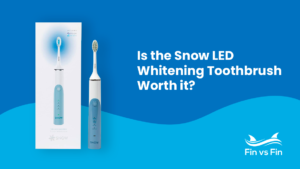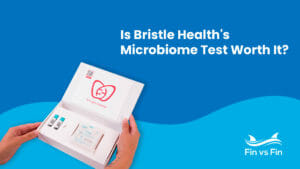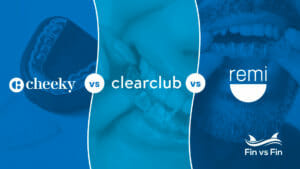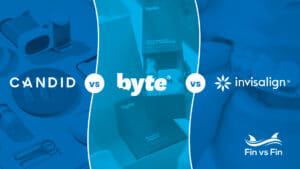It’s a fact that our teeth get darker as we get older. Even for the oral hygiene all-stars out there, the longer we live, the more our teeth are exposed to things that will stain them. Genetics do play a part in natural yellowing or greying, along with what we eat (hello, coffee!). But while whitening used to be limited to a service you would receive in the dentist’s chair with complicated molded trays and gels, it is now easier than ever to whiten your teeth quickly, comfortably and affordably from home and on the go.
The home-whitening wave began with strips, but now anything from LED light devices to whitening gels to charcoal powder have become popular ways to brighten your smile. Just like any new health trend, it can be hard to understand:
- Which products are effective at whitening your teeth?
- Which whitening products are safe to use?
Because when we whiten we are technically messing around with the enamel on our teeth, it is important to be careful about product choices. And just like many of the health products that we love and use daily, whiteners are not actually regulated by the FDA.
In this piece, we’ll take a closer look at whitening strips from three of the top brands and compare them detail by detail: Crest Whitestrips, the long-standing market leader, vs Burst vs Zimba, newer products that add a natural health and convenience element to traditional whitening methods.
How do at-home teeth whitening kits work?
We all probably understand the concept of bleaching to clean something, and so using peroxide to remove stains seems like a pretty simple idea as well. But teeth are actually pretty complicated! The first layer on our teeth, or the enamel, is actually a tiny network of tubes. Staining actually happens in the next layer below, or the Dentin. Whitening works by traveling through this tubular superhighway in the enamel to reach the Dentin. In this process, the peroxide breaks up into two other compounds: oxygen and hydroxyl radicals. Now these two chemicals go to work breaking up, or oxidizing, any stains on the teeny tiny pores in Dentin, and releasing them from the tooth.
Source: Burst
Here, the peroxide hits the outside of your teeth, or the enamel layer, and then turns into oxygen and something called hydroxyl radicals. These two compounds can then do what’s called oxidation to the stain- breaking up the substance that is causing the stain and releasing it into pieces into the mouth. For bigger and deeper stains, the more times this is done, the better.
Is peroxide safe for teeth whitening?
Hydrogen Peroxide is safe for home health use, just as long as it’s diluted enough. Most teeth whitening products are going to have levels of peroxide between 3% and 15%, with the lower amounts generally considered more safe. (As a point of reference, household peroxide you might keep in your medicine cabinet is usually 3%).
Since tooth enamel is extremely tough- the hardest substance on the body, actually- it is not easy to damage, and so it is not permanently hurt by the whitening process. What does happen is that the enamel gets dehydrated and temporarily unable to do its job of protecting the dentin. During that time your teeth are extra susceptible to new stains, and sensitive to hot and cold since the nerves aren’t protected. About two thirds of whitening kit users report having some level of sensitivity soon after using whitening products.
For some people with weak or previously damaged enamel, the whitening process will make this sensitivity much worse. Those people should work with a dentist to make sure they choose a whitening product that works for them, or choose a product with a lower concentration of peroxide to use over a longer period of time. So if you have sensitive teeth, you should consult your dentist before trying DIY whitening.
Similarly, those who are developing an all-over gray or yellow hue to their teeth that doesn’t seem to be linked to consuming coffee, soda or wine should talk to their dentist. This is likely to be genetic (or some other condition) and might not respond to at-home whiteners like the ones in this article. Your dentist might be able to provide a service that does help, however.
Overall though, the research shows that most people do not have any long term sensitivity or damage from using peroxide based whitening products. The key here is to use them as directed, with time in between to let your enamel recover.
So now that we know how they work, let’s take a look at the differences between Burst, Zimba, and Crest Whitestrips whitening strips.
Zimba vs Burst vs Crest Whitestrips: How do these teeth whiteners compare?
Crest has long been a household name, and so it follows that their whitening strips have held the spot for most popular home teeth whitening since day one. But a couple of newer startups like Zimba and Burst have recently gained a following for whitening products, toothbrushes, and floss that use more natural ingredients like charcoal and coconut oil. Which one should you trust? Let’s see how they compare:
Best Whitening Strips: Crest vs Burst vs Zimba |
Time Commitment | Peroxide Strength | Additional health benefits from coconut oil? | ADA Seal of Approval? |
| 30 minutes | 14% | No | Yes | |
| 10 minutes | 6% | Yes | No | |
| 30 minutes | 6% | Yes | No |
The main differences between these brands are:
- Peroxide strength (the concentration used)
- Time commitment needed to see results
- The addition of coconut oil (and all its benefits)
- Each company’s focus / core competency
At this point you may be asking: what exactly does coconut oil have to do with teeth whitening? We dug a little deeper to see what dentists think.
Why do Burst and Zimba use coconut oil for teeth whitening?
Burst and Zimba include a special ingredient — coconut oil — in their whitening strip formula. But why? Well, coconut oil has been used to boost dental health for literally hundreds of years. As a traditional Indian folk remedy, oils like coconut have always been used in a method called “oil pulling,” or basically using the oil as a mouth wash. This was believed to fend off tooth decay, bad breath, gum disease, dry mouth bleeding gums, dryness of throat, and cracked lips. Since a time long before toothpaste, oil pulling was even believed to strengthen teeth, gums and even the jaw.
But in recent times oil pulling has seen a popular comeback. Research suggests that oil pulling therapy shows a reduction in plaque, healthier gum lines, and lowered bacterial counts for people with gingivitis. The way that it is supposed to work is that oils are able to pull bacteria from all the nooks and crannies of your mouth, which then can be spit out with the oil– hence the term “pulling.” Coconut oil also has the added benefit of lauric acid which is a known antimicrobial, and a recent study found that it may also help prevent tooth decay. So by adding the coconut oil to its strips, Burst may be adding a long list of beneficial effects along with whitening.
What is the cost for Zimba vs Burst vs Crest Whitestrips?
Affordability goes a long way when it comes to choosing a product that you plan on using long term. When we break down the per treatment cost, Zimba does come out a little cheaper by a full dollar or so.
Pricing: Burst vs Zimba vs Crest White Strips | |||
|---|---|---|---|
| Starting Price | $19.99 for 1 week supply (Full results in 7 days) | $29.99 for 12-day supply (Full results in 10 days) | $24.99 for 14-day supply (Full results in 14 days) |
| Discounts? | 25% off with subscription | 10% off with email signup, 5% off with subscription | 50% off your first order, 20% off with subscription |
| Daily cost per whitening treatment | $2.85 | $2.49 | $1.79 |
| Shipping | Free | Free | Free |
| Free Cancellation | 90 day guarantee | 60 day guarantee | 90 day guarantee |
| Website |
However, if we look into what we are getting for the money, there’s more to the story.
Since Crest has almost double the peroxide strength as Burst or Zimba, you would in theory have to use the newcomers for longer to get the same results. In fact, studies do show that using a 5% peroxide product gives you the same amount of whitening as one of a higher strength if used for a longer period of time. Thus Crest Whitestrips might actually be more bang for your buck as far as how many times it has to be purchased and used, and how quickly it works. That said, higher concentrations of peroxide often cause teeth sensitivity, which is uncomfortable enough for many to steer clear of whitening products altogether. At a full dollar cheaper per day, Zimba may indeed be the most economical choice, especially for those curious about coconut oil.
What is it like to use Crest Whitestrips?
Source: Crest
Crest Whitestrips are meant to be used for 30 minutes, every day, for a period of 10 days. They work best on clean teeth without plaque, so brushing first is not a bad idea.
They are thin, transparent, and don’t cause excessive salivation, so they can be worn while relaxing as well as during most household activities. They aren’t super visible from a few feet away either, so it’s possible to make errands if need be too.
Whitestrips are small and are only meant to cover the front teeth. The top strip is what you would imagine: long and rectangular, covering all of the top teeth except for the molars. But the bottom strip is smaller, and its shape is a combination of two rectangles, which could take a little bit to figure out. The larger side of the bottom strip is actually meant to cover the visible front side of your bottom teeth, and the smaller one to anchor the strip in the back.
Once you’ve had them on for thirty minutes, it’s not a bad idea to either rinse with water or go for a full toothbrushing, based on your comfort level and how much of the sticky whitening gel from the strips remains on your teeth.
Crest whitestrips come in packs of 24, and the recommended use is for 10 days every 90 days. So out of three months, you can choose a time where you are able to whiten for 10 consecutive days. Ideally, you won’t be drinking coffee, dark soda or wine very much during this time period, especially just after whitening, but hey, you do you.
Whitestrips don’t generally affect crowns, caps, or other dental work, but it’s a good idea to check in with your dentist if you have specific concerns about using whitening products.
What is it like to use Burst whitening strips?
Similar to Crest, Burst’s whitening strips are designed to be used once a day. But with Burst, you only whiten for 7 days instead of 20. And instead of waiting 30 minutes, you only need to take a quick 10 out of your day for Burst’s strips to make an impact. So the whole whitening process takes much less time than with Crest Whitestrips.
Source: Burst
The Burst strips themselves are very similar to Crest with one long rectangular strip for the top teeth, and a smaller double rectangle for the bottom. You simply press them on until they adhere, and go about your normal business for 10 minutes.
Source: Burst
Just like Crest, it’s a good idea to brush first, and rinse after for best results. But with Burst, rinsing afterwards each time is more strongly advised to maximize the effects of the coconut oil. Burst says that since the coconut oil is working so hard to pull the bacteria and toxins from the corners of your mouth, it’s best to rinse and spit afterwards, just like using mouthwash. Then after your seven days of whitening with Burst, you’ll want to repeat every 90 days.
Source: Burst
Burst comes in packs of 14 strips, meant to be replaced every 3 months. Reviewers say that they see results within one week, and the reviews on Burst’s website average 4.9 out of 5 stars.
Review of Zimba whitening strips
Source: Zimba
Zimba’s whitening strips are just as easy to use as the rest. Like Crest, Zimba recommends wearing their strips on your front upper and lower teeth for 30 minutes a day. Their strips are sold in boxes of 28 — which is a 14-day supply — and best results are typically seen after all 14 days. Thus Zimba takes twice as long (+7 days) as Burst to see optimal results, and 4 days longer than Crest.
That said, assuming you’re not on a crazy tight schedule, Zimba offers a few big advantages over its competitors. First is reduced risk of tooth sensitivity due to lower concentration of peroxide. Second is added health benefits of coconut oil. And third is the unparalleled price.
Full disclosure: Zimba sent us samples of their whitening strips. I found them easy to apply and to my surprise, quite minty fresh tasting. I started noticed whiter teeth in about a week, and thankfully unlike my experience with Crest Whitestrips, my teeth didn’t feel brittle or in pain.
How well do Crest Whitestrips work?
Users report seeing results within about 3-7 days of using Crest Whitestrips. Results will vary depending on the level of staining for each individual of course, but Crest is known for pretty quick results. Your teeth should be a shade or two lighter each time you use them.
But continuing to use Whitestrips for the full twenty days should both improve your results and make them last longer. For some, this initial effect can last for up to two years, and may report about 6 months. But the suggested schedule for maintaining your whitened teeth is to repeat the 10-day whitening period every 3 months.
Beyond strips: What other whitening products do Crest, Zimba, and Burst offer?
Now that we know the ins and outs of Crest and Burst’s whitening offerings, let’s take a look at the various products available from both companies. Crest now offers a blue LED light along with many of its Whitestrips kits, which they guarantee will boost the effects of using the strips as directed.
The LED light is worn for the last 10 minutes of wearing Whitestrips. The way it works is that the light penetrates enamel to weaken stains, accelerating the action of the peroxide in the strips. Colgate has a similar LED whitening offering ShopSmiles that we’ve previously reviewed, and we’ve also covered brands like Glowup in the past if you want to compare the top LED whiteners.
Burst may only have one line of whitening strips, but they do offer some other interesting dental products! Their claim to fame is actually a charcoal-based toothbrush, but they offer charcoal floss as well.
Just like coconut oil, charcoal has a long history of being used for dental health, both to absorb toxins and whiten. And Burst is not the only company to dig into ancient history for ingredients: charcoal whitening is definitely trending.
Zimba offers a whitening pen in addition to their whitening strips. Their pen is portable so you can easily paint your teeth and whiten on the go. It’s recommended to keep the pen’s gel on your teeth for 15 minutes before rinsing. Overall, this is a pretty cool weapon to have in your teeth whitening tool kit.
What are customers saying about Crest Whitestrips and Burst?
Both Burst and Crest have very positive reviews. Because Crest Whitestrips have been around longer, there are generally more reviews out there. They are also sold via many websites other than their own, like Amazon, CVS, walgreens… even Ebay! So it is much easier to find positive user testimonials about Whitestrips. But that doesn’t mean no one is singing Burst praises… users seem to really like the coconut taste of their strips. They are generally considered easy and pleasant to use without much of a chemical taste.
The biggest theme we see with Burst reviews is that they do not seem to cause sensitivity or pain, and so people with sensitive teeth can safely use them. (Again, this is what the Burst reviews are saying). As far as the more natural products go, Burst strips are much easier to use than other charcoal products, and because they contain that magic ingredient, peroxide, users do see results after a few uses.
For Crest, people review them as easy to use with fast and dramatic results:
Crest Whitestrips are cost effective to maintain a white smile over many years, and are reliable for touch-ups before a big event or photoshoot.
The Verdict: Which at-home teeth whitener is right for you — Burst or Crest Whitestrips White Strips?
So which whitening strips do we ultimately recommend trying?
Well, we know that Crest is a more powerful product due to its higher peroxide strength, and so it is going to work faster. So if there is an event coming up and you need a strong effect quickly, you’re going to want to take no chances and reach for the Crest Whitestrips.
However, if you have dental health issues, are worried about enamel, or even just want to up your oral health game, Burst offers more with fewer risks. The additional coconut oil and lower peroxide content make Burst a better choice for long term use as well. Burst considerably more expensive than Zimba, however, which is our #1 pick and offers all the same benefits. The only downside is a slightly longer time to see optimal results (14 days with Zimba vs 10 with Crest)
Like anything, the best whitening product for you will depend on personal needs and values. That includes how sensitive your teeth are, how much whitening you need, how quickly you need it done, and, as always, your budget.
We hope this review helps you with your decision making! Please don’t hesitate to reach out if you have questions, or drop us a comment below. If you’ve tried whitening strips from Zimba, Burst or Crest, we’d love to hear about your experience.
Frequently Asked Questions (FAQ)
How much does Burst cost?
Daily cost per whitening treatment is $2.85
How much does Zimba cost?
Daily cost per whitening treatment is $2.49
How much does Crest White Strips cost?
Daily cost per whitening treatment is $1.79
Discover more dental care reviews

SNOW Toothbrush Review – How Does it Compare to Sonicare, Quip, & Burst?
Have you noticed their teeth becoming more susceptible to stains as your age? If I thought red wine stained my teeth in college, boy, was

Bristle Health Review – Is the Oral Microbiome Test Worth It?
Bristle Health Overview Test measures: Complete oral microbiome (700+ bacteria, viruses, and fungi) Test costs: $149 Provides scores for: Chronic bad breath, inflamed gums, oral

Byte Before And After – What Kind of Results Can You Expect?
Gone are the days of having to actually go to the orthodontist to get the perfect smile. With the innovation of affordable at-home teeth aligners,

Cheeky vs ClearClub vs Remi: What’s the Best Custom Night Guard?
In this review, we compare custom night guards from Cheeky vs ClearClub vs Remi to help you decide if any are right for you.

Byte vs AlignerCo: Which Low-Cost Aligners Are Best?
If your smile isn’t perfectly straight, you’re not alone. Most of us aren’t born with straight teeth, and even for those lucky few that are,

Candid vs Byte vs Invisalign: The Best Teeth Aligner Kit for Your Budget
If you were one of the unlucky ones, you remember painful visits to the orthodontist in your teens. The sticky leather chair, picking out your


















